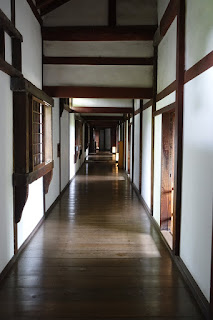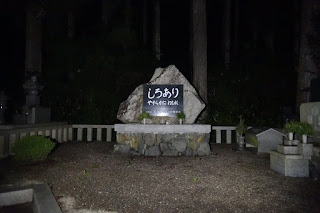I tried using my backup battery and it would only load to the Verizon screen. I tried holding down various buttons to try to get it to load into recovery mode. It went into safe mode instead. I turned off safe mode and it loaded up normally. Now I am just crossing my fingers that that does not happen again!
Once on the bus, it was a quick ride to the cable car. With the bus, cable car, and train all scheduled so they could be boarded one after another, it was a super smooth transition. There were only a handful of people going in this direction, with tons coming up the mountain.

The plan was to stop at Namba Station, about an hour into my train journey, to do a quick stop at the Folk Arts/crafts museum. I used the coin lockers to put my bags away and walked five minutes to get there. I arrived right when it was supposed to open. It was closed. Google revealed it was closed every Monday. Lame. On a hunch, I looked up the museums I wanted to go to near my final destination. The major one was closed, as were all art museums in the area. I decided on a change of plans for the day. Instead of rushing to get to my hotel town of Okayama and then speeding over to the museums, I would stop at Himeji, and see what it is supposed to be the greatest castle in Japan. I took a bullet train from a nearby station to Himeji.

Himeji Castle is well known because it is a huge complex and has survived through the years. You could see it right after you walk out the doors of the train station. Using the coin lockers, I went straight for the castle. For an extra 35 cents or so, I got the combination ticket with the bordering garden. It was hot today. A warning announcement went over the loudspeakers on the castle grounds to make sure to stay hydrated. I looked up the weather report for the exact temperature, and it was 93.

When walking into the castle, they handed us a plastic bag. We were told to take off our shoes and hold them in the plastic bag. The castle has six floors. Each floor was pretty much empty. I climbed my way to the top, where there were some nice views.

 |
| I have taken to noticing the circular tiling on roofs, from viewing roof tiles in craft shops |




I learned that some of the building blocks for the castle were stolen from burial mounds around Himeji. There was also a well with a legend surrounding it. There was an ancient artifact on display with a house seal on it.






At the gift shop, for only $20, you could can Lego Himeji Castle!

The bordering garden wasn't very large and didn't have many views of note. Here were my two favorites.


While waiting for the next bullet train, to Okayama, the track above would make the building rumble when trains came overhead. When I was on the track, a bullet train came through without stopping, and the speed was absolutely incredible. I kept my camera in hand and was prepared to videotape the next one that came, but instead, my train was next.
Right outside Okayama station there was a statue with a bird attached, along with some real birds. My hotel was directly across the street. It was a bit unusual, in that the hotel itself didn't start until the 5th floor. They even have air conditioning turned on in the hallways! It is great to be back in the air conditioning, especially on a day like today.


After a short rest, I went downstairs. It was raining. I went back to the eighth floor, grabbed my umbrella, and went downstairs. It was drizzling. I was on my way to Korakuen. There are three great gardens, so they say, in Japan. The first is the one I went to in Kanazawa, Kenrokuen. This is another. On the way, I saw a bus with cats on it.

Nearby, I could see Okayama castle. I did not intend on seeing this castle. When I arrived at the garden ticket gate, I was informed that seeing the castle would only cost $1 more. I figured, why not! Then, after I bought the ticket, the woman told me that I better go there first, since it would close in fifteen minutes. I ran back over the bridge.
The best thing about the inside of the castle was that the bottom half had air conditioning! There was a small display of artists and their pottery creation on the second floor, which was neat. The next two floor had a few artifacts.



This one had different goals in mind when it came to design. It is supposed to be created as more of a landscape garden, with different views at each turn. It started to rain when I arrived. The weather seemed to have discouraged others from visiting. I pretty much had the whole place to myself.
The garden was very spacious. It was a bit too spacious for my tastes. The views were made worse by the huge area used for an event of sorts, with a large amount of white chairs and tents in the middle of the place.



I decided to go to the museums tomorrow morning. For now, though, I was going to check out the neighboring town that housed them. Kurashiki is a town about fifteen minutes away, with an old district built around a canal. Once on the train, I learned that it was pronounced "Kurashki." Keep in mind that "r"s are pronounced with a light "d" sound in Japanese.
On the train ride, I observed a few college aged(or high school) kids joking around and flirting with each other. This was the first time I had observed such a thing in Japan. We had noticed this in Taiwan, but not here. The people that I've interacted with have all been polite, even cheerful, but never this relaxed. It was nice to see. I am unsure if it is just that they are of a younger generation, with the generation divide being larger in Japan, or if I simply hadn't been exposed to much of it because I have been in so many rural areas or what have you. Out of curiosity, I looked up whether Kurashiki was a college town. There are indeed quite a few colleges.



All the shops were closed by now, but it is a beautiful area, and by this time, the weather was cooler. I spent some time observing a bird near the water, while a fellow was tossing bread crumbs into the water to feed the fish, and I figured, helping bring fish to the surface for the bird to grab.

I passed some of the museums I intend to visit tomorrow, such as this building, which is the oldest Japanese museum of western art.





















